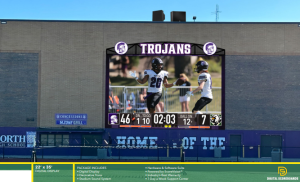Author speaks to D99 schools about alcohol
November 6, 2015
Author of New York Times best-selling memoir “Smashed”, Koren Zailckas, spoke to DGN on Oct. 16 at this year’s Red Ribbon Week assembly in the Clarence Johnson auditorium. This double second period assembly was only one component in the school’s broader drug and alcohol prevention program.
Zailckas’ book chronicles the events of her decade-long struggle with alcohol, which began at age 14 and continued until 23. Almost 10 years after she began drinking, Zailckas decided tell her side of the binge-drinking phenomenon that is spreading amongst today’s youth, especially young women.
“At 23, I was just beginning to quit drinking and beginning to reflect on how my drinking had been really an expression of my unhappiness and my lack of confidence,” Zailckas said. “I really published Smashed because I wanted to offer the younger women’s perspective. The only people who were talking about why girls like myself were drinking were [college professors] who had been removed from the college drinking scene for quite a while.”
Recently out of college, sober, and living in Manhattan, Zailckas couldn’t shake one specific drunken memory from her mind of a time when she almost died and got her stomach pumped at the age of 16. This memory that she hadn’t thought about in years eventually became a chapter in what is now her published memoir.
“We liked that she had a similar experience to our students,” student assistance coordinator Keith Bullock said. “She had a suburban upbringing and she also primarily abused alcohol in high school and in college. It wasn’t so much that her substance abuse progressed to something extreme like intravenous drug use, so we thought that her experience would resonate more with our students if they themselves have experimented [with alcohol] or have a friend or a parent who struggles with alcoholism.”
According to DGN’s results from the Illinois Youth Survey in 2014 (a self-report survey that gathers information on a wide variety of health and social topics) an average of 18% of students binge drink (consume five or more drinks in a row) like Zailckas did, which is close to the state average of 18.25% and the Dupage county average of 17.5%*. Students who reported drinking in the last 30 days used alcohol more than any other substance, with types of alcohol like beer (from bottles or cans) and liquor (vodka, whiskey, etc.) reported as the most commonly used.
The IYS is a self-report survey that gathers information on a wide variety of health and social topics that schools distribute every two years. Although schools are not required to administer the survey, some schools, including DGN, give out the survey to be able to receive school-specific results.
One way that the district uses the IYS results is for the “most teens” marketing campaign. According to the Student Assistance page on both schools’ websites, the campaign emphasizes evidence that proves that most students are not using substances, purposefully challenging the assumption that “everyone is doing it” and uses IYS results to support their claims.
Numerous posters and infographics throughout the school and online present IYS statistics using a social norms approach. According to the National Social Norms Institute, this approach utilizes data to combat misperceptions regarding how many people areactually using substances.
Operation Snowball, a leadership program that focuses on drug and alcohol prevention, shares values with DGN’s “most teens” campaign. The 2015 fall Snowball directors helped out with Zailckas’ presentation by introducing her and facilitating a short question and answer session after her presentation.
“The name Operation Snowball comes from the idea of a snowball effect; as one person adopts a certain lifestyle, it leads to more people adopting that same lifestyle,” Snowball director senior Maria Derrig said. “The different parts of RRW do just that. Everything students see around school that tie into ‘most teens’ or PBIS lessons is to promote healthy lifestyles.”
Throughout the years that DGN has held events for Red Ribbon Week, numerous speakers have come in to talk to students about their experiences with substance abuse. In 2013, former NBA player Chris Herren spoke to the school about his experience with hard drugs. This year, Zailckas had a more intimate presentation in the auditorium, rather than the main gym like Herren.
“My overall reaction to Koren’s presentation was that she seemed very relatable. Her story seemed very practical and wasn’t very extreme,” Snowball director senior Ben Goodell said. “In the past, we’ve had speakers with pretty amazing stories. These stories were effective, but it is also good to look at the issue from another point of view. I felt like the story she shared could easily happen to many people.”
According to book club member freshman Marion Deal, who read Smashed, Zailckas’ presentation lacked depth, which may have led to some students’ negative reaction to the presentation.
“She brushed off some hideous events with an almost cavalier attitude, and seemed to be lacking a comprehension of just how impactful her experiences were. I believe that, though she had the experience necessary to present at Red Ribbon Week, she didn’t have the depth of hindsight and self-clarity that was also needed,” Deal said.
Moving forward, Bullock is looking for other effective ways of sharing the IYS information to serve the overall purpose of helping teens make their own healthy choices.
*IYS averages were calculated using a holistic approach, giving each percent the same weight in the average. DGN numbers were comprised of all grade levels, while county and state numbers were based solely on 10 and 12 grade averages, due to the fact that those two grades were required by the survey provider.

























